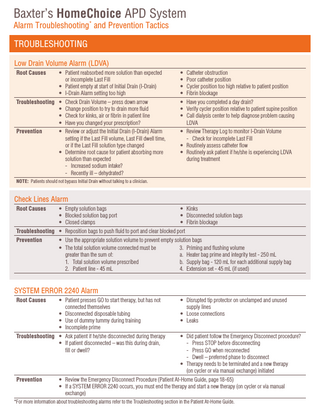Baxter
Peritoneal Dialysis Systems
HomeChoice APD System Alarm Troubleshooting and Prevention Tactics May 2011
Troubleshooting and Prevention Tactics
2 Pages

Preview
Page 1
Baxter’s HomeChoice APD System Alarm Troubleshooting* and Prevention Tactics
TROUBLESHOOTING Low Drain Volume Alarm (LDVA) Root Causes
• Patient reabsorbed more solution than expected or incomplete Last Fill • Patient empty at start of Initial Drain (I-Drain) • I-Drain Alarm setting too high
• Catheter obstruction • Poor catheter position • Cycler position too high relative to patient position • Fibrin blockage
Troubleshooting • Check Drain Volume – press down arrow • Change position to try to drain more fluid • Check for kinks, air or fibrin in patient line • Have you changed your prescription?
• Have you completed a day drain? • Verify cycler position relative to patient supine position • Call dialysis center to help diagnose problem causing LDVA
Prevention
• Review Therapy Log to monitor I-Drain Volume - Check for incomplete Last Fill • Routinely assess catheter flow • Routinely ask patient if he/she is experiencing LDVA during treatment
• Review or adjust the Initial Drain (I-Drain) Alarm setting if the Last Fill volume, Last Fill dwell time, or if the Last Fill solution type changed • Determine root cause for patient absorbing more solution than expected - Increased sodium intake? - Recently ill – dehydrated?
NOTE: Patients should not bypass Initial Drain without talking to a clinician.
Check Lines Alarm Root Causes
• Empty solution bags • Blocked solution bag port • Closed clamps
• Kinks • Disconnected solution bags • Fibrin blockage
Troubleshooting • Reposition bags to push fluid to port and clear blocked port Prevention
• Use the appropriate solution volume to prevent empty solution bags • The total solution volume connected must be 3. Priming and flushing volume greater than the sum of: a. Heater bag prime and integrity test - 250 mL 1. Total solution volume prescribed b. Supply bag - 120 mL for each additional supply bag 2. Patient line - 45 mL 4. Extension set - 45 mL (if used)
SYSTEM ERROR 2240 Alarm Root Causes
• Patient presses GO to start therapy, but has not connected themselves • Disconnected disposable tubing • Use of dummy tummy during training • Incomplete prime
Troubleshooting • Ask patient if he/she disconnected during therapy • If patient disconnected – was this during drain, fill or dwell?
Prevention
• Disrupted tip protector on unclamped and unused supply lines • Loose connections • Leaks • Did patient follow the Emergency Disconnect procedure? - Press STOP before disconnecting - Press GO when reconnected - Dwell – preferred phase to disconnect • Therapy needs to be terminated and a new therapy (on cycler or via manual exchange) initiated
• Review the Emergency Disconnect Procedure (Patient At-Home Guide, page 18-65) • If a SYSTEM ERROR 2240 occurs, you must end the therapy and start a new therapy (on cycler or via manual exchange)
*For more information about troubleshooting alarms refer to the Troubleshooting section in the Patient At-Home Guide.
Baxter’s HomeChoice APD System Teaching Opportunity - Alarm Simulations
STEPS TO SIMULATE THE:
STEPS TO ADDRESS ALARM:
Low Drain Volume Alarm
When Alarm Occurs
• Training prescription – CCPD • Therapy volume – 4900 mL • Therapy time – 1:30 • Fill volume – 1100 mL • Last Fill volume – 500 mL • Dextrose – Same • I-Drain Alarm – 350 mL • Dummy tummy should have 100-150 mL of solution, no air present in dummy tummy • Review Troubleshooting section in Patient At-Home Guide while waiting for alarm to occur
• Turn to Troubleshooting section in Patient At-Home Guide – walk patient through action items • Discuss with patient when he/she should bypass an alarm • Review treatment data – drain volumes • Has patient changed position and repeated drain cycle? • Emphasize importance of notifying dialysis clinic if patient had to bypass
Check Patient Line Alarm
When Alarm Occurs
• Close the clamp on the patient line during Drain or Fill until the system alarms – CHECK PATIENT LINE • Auto Restart alarm
• Turn to Troubleshooting section in Patient At-Home Guide – walk patient through action items • Have patient check the line referenced • Have patient correct alarm • Patient did not need to press any buttons
SYSTEM ERROR 2240 or 2267 Alarm
When Alarm Occurs
• Total volume = 6000 mL • Therapy time = 1:30 • Fill volume = 2000 mL • Last Fill volume = 2000 mL • Dextrose = Same • I-Drain Alarm = 1400 mL • Dummy tummy should have 2000 mL of solution • Disconnected during dwell, did not press STOP, and left clamp open on patient line
• Press STOP to mute the alarm • Write down the System Error number and treatment phase that appears on the display screen • Turn the power switch OFF and ON to end therapy – SYSTEM ERROR 2267 appears • Press the power switch OFF and ON again – PRESS GO TO START appears • Close all clamps • Discard the disposable set and solution bags • Notify dialysis nurse • Complete treatment with a manual exchange -OR• Set up the cycler with new supplies
Caution: Federal (U.S.) law restricts this device to sale by or on the order of a physician or other licensed practitioner. For safe and proper use of this device, refer to the device Operator’s Manual. Baxter and HomeChoice are trademarks of Baxter International Inc. AL11081 05/11